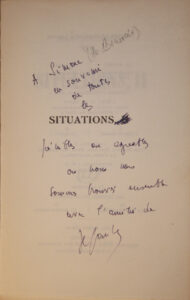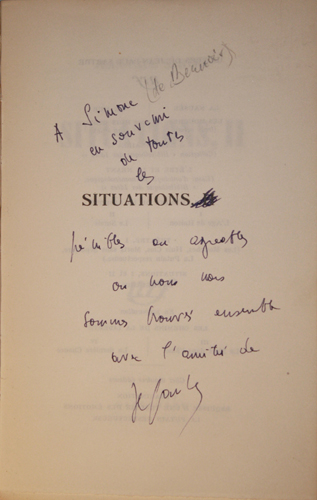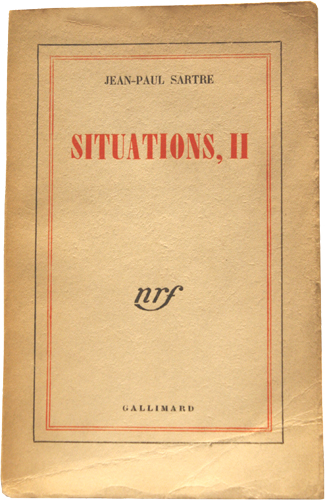SARTRE, Jean Paul. Situations, II. [Paris], Gallimard, 1948.
8 vo [187 x 107 mm], 330 pp., (6). Sewed, untrimmed.
One of 5 copies printed on velin pur fil navarre (marked E) from a total edition of 1109, the second paper after 14 copies printed on velin de Hollande.
“Situation II (1948) assembles three texts: “Présentation des Temps modernes”, “La nationalisation de la littérature” and “Qu’est-ce que la littérature?” all published between 1945 and 1947 and all about the role of literature in society. “Présentation des Temps modernes” is the manifest of this review, which Sartre created in 1945. Sartre expounds his plans and his intentions.“La nationalisation de la littérature” exposes the situation of literature after the war. Literature played an important part during the Resistance, that’s why we tend to consider it as a national property, as an official speech. (…) The most important article of this collection ”Qu’est-ce que la littérature?” was published in the “Temps modernes” in 1947. Sartre analyses his matter in three questions, “Qu’est-ce qu’écrire?” (“What is it to write?”), « Pourquoi écrire? » (“Why to write?”), “Pour qui écrit-on?” (« Who do we write for? »), that form the three parts of this work, ended with a fourth survey, “Situation de l’écrivain en 1947” (“Situation of the writer in 1947”). In the first part, “Qu’est-ce qu’écrire?” (“What is it to write?”) Sartre underlines the specificity of literature in comparison with other arts. Literature is responsible for the senses that it develops (…). The writer has to be fully aware of his means and his intentions, which leads to the question: “Pourquoi écrire?“ (“Why to write?”) . First of all the writer writes to be read. (…) Writing refers to a lecture, which leads to this third question: “Pour qui écrit-on?” (« Who do we write for? »). Sartre insists on the contradictions caused to the writer by his usually “bourgeois” origins and the universality to which he aspires: he wants to apply to everybody. […] In the last part, “Situation de l’écrivain en 1947” (“Situation of the writer in 1947”), Sartre defines in a more precise way the role of the French writer.” (Dictionnaire des Oeuvres, VI, 154).
Exceptional copy dedicated by the author to Simone de Beauvoir. Jean-Paul Sartre judiciously used the term “Situations” of the half-title to write a very personal dedication: “To Simone in remembrance of all the painful or pleasant [Situations] in which we found ourselves together with best wishes from Jean-Paul.”
It was in 1929 that Simone and Sartre met at the Sorbonne and began their communal life as well as their permanent collaboration and intellectual dialogue, which lasted for over fifty years. The couple Beauvoir-Sartre represents an ideal: this unique relationship relies on the respect of each other freedom and on the intellectual equanimity of the two lovers. This couple put his stamp on the 20th century and continues to fascinate.



